This isn't as large and doesn't have as many outstanding artifacts as Palazzo Massimo, and it's a long walk from the nearest metro station, but if you're at Piazza Navona with a bit of time to spare and a ticket to the National Museums of Rome which is not yet expired, it is worth a quick visit.
In my 2014 visit, I took the time to explore this museum in much more detail, and here are my photos from that visit:

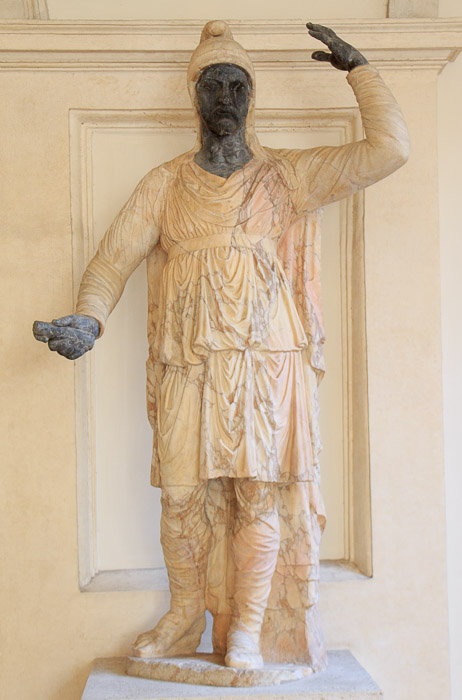
IMG_9561-20141010: Colossal statue of a Dacian in Numidian yellow marble, with the exposed parts of the body restored in black marble, in the National Museum of Rome, Palazzo Altemps, part of the architectural decorations of the Basilica Aemilia in the Roman Forum, and therefore dated to the Julio-Claudian period.
See all
National Museum of Rome - Palazzo Altemps photos.

IMG_9563-20141010: Colossal statue of a Dacian in Numidian yellow marble, with the exposed parts of the body restored in black marble, in the National Museum of Rome, Palazzo Altemps, part of the architectural decorations of the Basilica Aemilia in the Roman Forum, and therefore dated to the Julio-Claudian period.
See all
National Museum of Rome - Palazzo Altemps photos.

IMG_9566-20141010: Colossal Group with Dionysus and a Satyr, a Roman copy of 160-180 AD of a Greek original of the 4th century BC, in the National Museum of Rome, Palazzo Altemps. Dionysus is portrayed with idealized Apollonian beauty, and is flaked by a satyr who supports him. The group might have decorated been from the Baths of Constantine, near the spot on the Quirinale hill where it was found.
See all
National Museum of Rome - Palazzo Altemps photos.

IMG_9567-20141010: Colossal Group with Dionysus and a Satyr, a Roman copy of 160-180 AD of a Greek original of the 4th century BC, in the National Museum of Rome, Palazzo Altemps. Dionysus is portrayed with idealized Apollonian beauty, and is flaked by a satyr who supports him. The group might have decorated been from the Baths of Constantine, near the spot on the Quirinale hill where it was found.
See all
National Museum of Rome - Palazzo Altemps photos.

IMG_9568-20141010: Colossal Group with Dionysus and a Satyr, a Roman copy of 160-180 AD of a Greek original of the 4th century BC, in the National Museum of Rome, Palazzo Altemps. Dionysus is portrayed with idealized Apollonian beauty, and is flaked by a satyr who supports him. The group might have decorated been from the Baths of Constantine, near the spot on the Quirinale hill where it was found.
See all
National Museum of Rome - Palazzo Altemps photos.

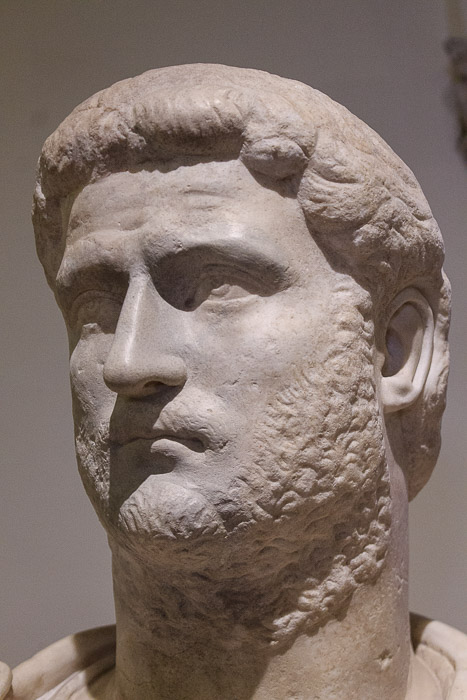
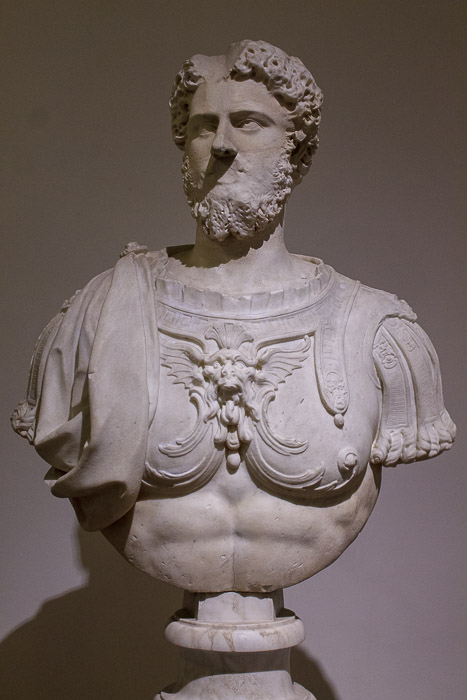
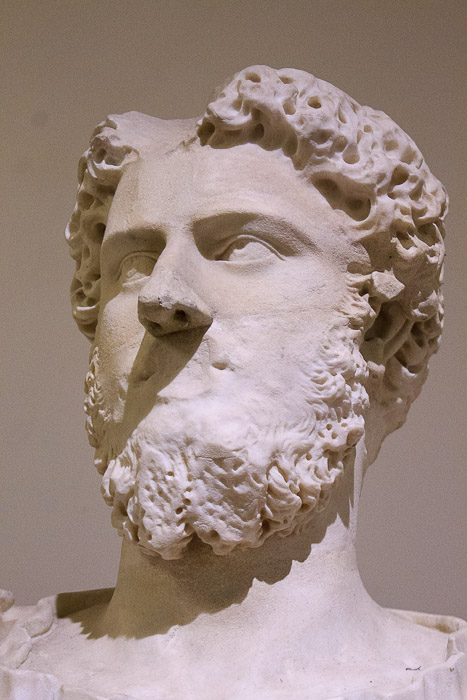

IMG_9579-20141010: Statue of a Maenad, originally placed in a niche since the back is only rough-finished, wearing an animal skin crossed over her breasts and holding a fawn in her left arm, which allows her to be identified as a Maenad or as Artemis, in the National Museum of Rome, Palazzo Altemps. The sculpture is tentatively dated to the mid 1st century BC. The head is ancient, but unrelated to the body, having been added on top of the body during the 18th century.
See all
National Museum of Rome - Palazzo Altemps photos.



IMG_9586-20141010: Athena, found near Santa Maria sopra Minerva in 1627, and reworked according to the wishes of its owner, even though originally probably depicted Hygieia, the daughter of Aesculapius, in the National Museum of Rome, Palazzo Altemps. Athena is shown in an unusual pose, calming a serpent who grinds his teeth in a theatrical expression of Baroque vivacity.
See all
National Museum of Rome - Palazzo Altemps photos.
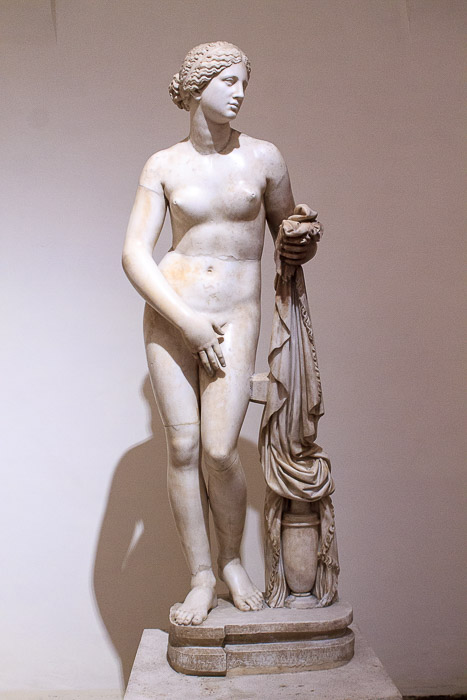
IMG_9588-20141010: Aphrodite (Venus) of Cnidos, stepping out of the bath, seeking to cover herself in a modest gesture, a Roman copy of the original 4th century BC Greek sculptor Praxiteles, in the National Museum of Rome, Palazzo Altemps.
See all
National Museum of Rome - Palazzo Altemps photos.

IMG_9591-20141010: Apollo Kitharoidos, in the National Museum of Rome, Palazzo Altemps. The torso is original, from the Hadrianic Period, while the head, left arm with the lyre, part of the left leg with the draper, the base, and the curved stick laying on the ground were added in the 17th century by Ippolito Buzzi, who used the Apollo Lykeios as a model.
See all
National Museum of Rome - Palazzo Altemps photos.

IMG_9592-20141010: Apollo Kitharoidos, in the National Museum of Rome, Palazzo Altemps. The torso is original, from the 1st century AD, and the head, neck, right shoulder, right arm, left arm and lyre, and left leg were added in the 17th century by Ippolito Buzzi, who used the Apollo Belvedere as a model.
See all
National Museum of Rome - Palazzo Altemps photos.

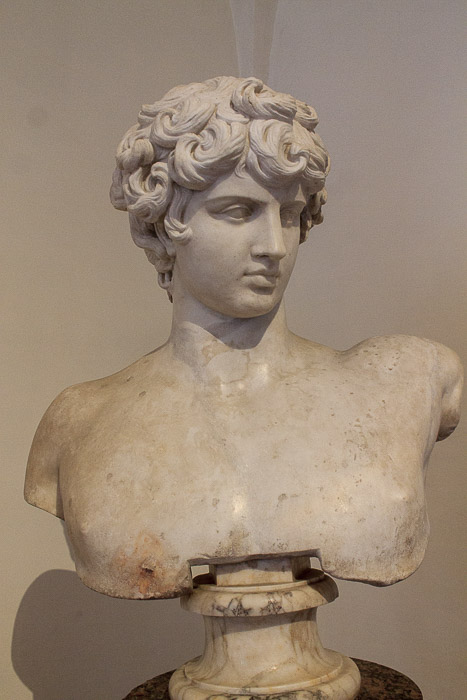
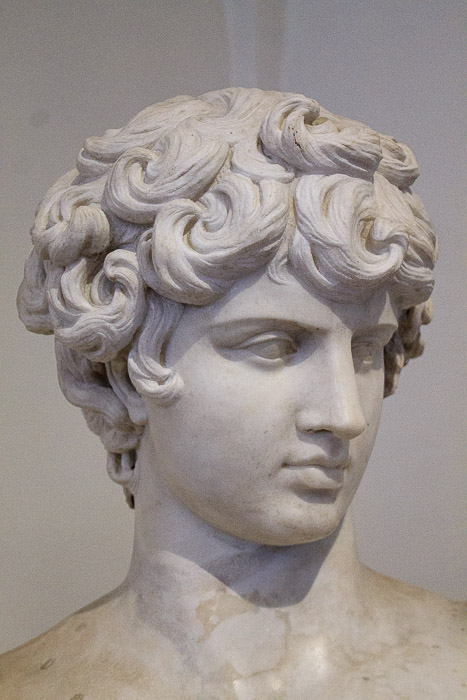
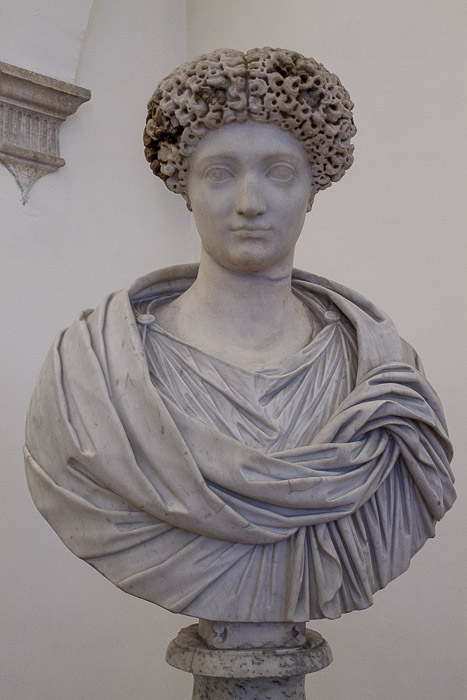

IMG_9600-20141010: Demeter (Ceres), the goddess who protects harvests, a 2nd century AD Roman copy derived from 5th and 4th century BC Greek prototypes, in the National Museum of Rome, Palazzo Altemps
See all
National Museum of Rome - Palazzo Altemps photos.
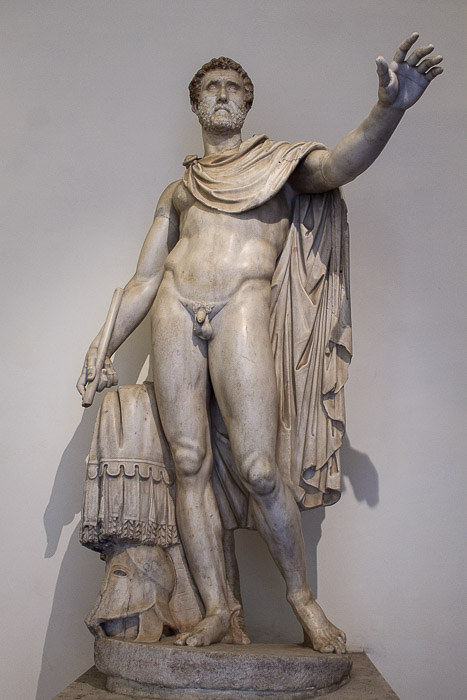
IMG_9602-20141010: Emperor Antoninus Pius in a heroic pose as a military commander, in the National Museum of Rome, Palazzo Altemps. The emperor wears only a mantle while his helmet and cuirass, his military apparel, lean against a tree trunk. The statue is inspired by Greek originals of the 5th century BC, the head is taken from a portrait of a youth created between 140 and 147 AD, and was restored by Ippolito Buzzi.
See all
National Museum of Rome - Palazzo Altemps photos.

IMG_9603-20141010: A 2nd-century BC herma of Athena, in the National Museum of Rome, Palazzo Altemps, weathered due to exposure to the elements since it was used as an outdoor ornament of a building or garden
See all
National Museum of Rome - Palazzo Altemps photos.

IMG_9604-20141010: A 2nd-century BC herma of Hermes, in the National Museum of Rome, Palazzo Altemps, weathered due to exposure to the elements since it was used as an outdoor ornament of a building or garden
See all
National Museum of Rome - Palazzo Altemps photos.


IMG_9609-20141010: Composite capital with four winged female figures represented in the so-called 'kneeling race' and four erotes holding baskets of grapes, from the early decades of the 4th century AD, in the National Museum of Rome, Palazzo Altemps
See all
National Museum of Rome - Palazzo Altemps photos.


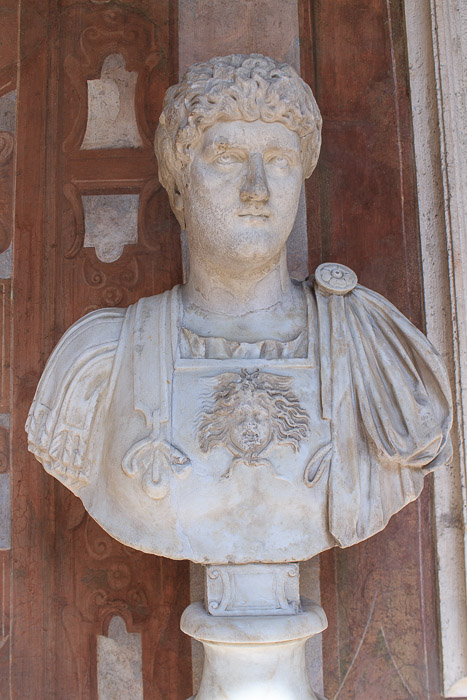




IMG_9620-20141010: The Ludovisi Gaul (a Gaul killing himself and his wife), in the Grand Hall of the National Museum of Rome, Palazzo Altemps, possibly linked to the Dying Gaul in the Capitoline Museum. The standing male figure is in the act of stabbing his neck with a short sword while supporting a dying woman with his left hand, who falls forward hat his side.
See all
National Museum of Rome - Palazzo Altemps photos.

IMG_9621-20141010: The Ludovisi Gaul (a Gaul killing himself and his wife), in the Grand Hall of the National Museum of Rome, Palazzo Altemps, possibly linked to the Dying Gaul in the Capitoline Museum. The standing male figure is in the act of stabbing his neck with a short sword while supporting a dying woman with his left hand, who falls forward hat his side.
See all
National Museum of Rome - Palazzo Altemps photos.

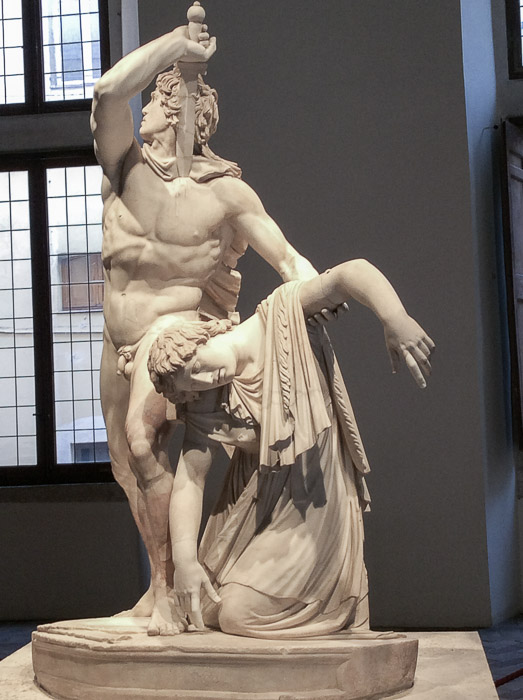
IMG_0209-20141010: The Ludovisi Gaul (a Gaul killing himself and his wife), in the Grand Hall of the National Museum of Rome, Palazzo Altemps, possibly linked to the Dying Gaul in the Capitoline Museum. The standing male figure is in the act of stabbing his neck with a short sword while supporting a dying woman with his left hand, who falls forward hat his side.
See all
National Museum of Rome - Palazzo Altemps photos.


IMG_9628-20141010: The Ludovisi Fury, interpreted at various times as a Sleeping Fury or a Medusa, or a water nymph, in the National Museum of Rome, Palazzo Altemps. When it entered the Ludovisi collection, the left side of the face was cut horizontally to improve the stability of the piece. The head, probably part of a large high-relief, is now believed to be a 2nd-century Roman copy of a Hellenistic work, perhaps a wounded Amazon.
See all
National Museum of Rome - Palazzo Altemps photos.

IMG_9630-20141010: The so-called Grand Ludovisi Sarcophagus, a colossal sarcophagus with scenes of battle between Romans and barbarians, in the National Museum of Rome, Palazzo Altemps. The front decorations are divided into 3 levels, with the victorious Romans depicted near the top with the deceased, dressed as a general, the center part showing the battle, and the lower part showing the defeated barbarians. Battle sarcophagi were commonly produced during the mid 2nd century and early 3rd century AD.
See all
National Museum of Rome - Palazzo Altemps photos.

IMG_9633-20141010: Pan and Daphnis, in the National Museum of Rome, Palazzo Altemps. The rustic deity Pan is teaching the shepherd Daphnis to play the syrinx (panpipes), the typical pastoral musical instrument made of reeds. It is a Roman copy of a 100 BC original by Heliodoros from Rhodes.
See all
National Museum of Rome - Palazzo Altemps photos.

IMG_9634-20141010: Satyr and Nymph, a Roman copy of the imperial period, inspired by a Greek original of the 2nd century BC, in the National Museum of Rome, Palazzo Altemps, depicting a lovers' quarrel between a satyr and a nymph, who seeks in vain to free herself from her insistent suitor. Both heads are 17th century additions. The head of the satyr is believed to be a work of young Bernini.
See all
National Museum of Rome - Palazzo Altemps photos.

IMG_9636-20141010: Fragment of a relief with the Judgment of Paris, from the first half of the 2nd century AD, in the National Museum of Rome, Palazzo Altemps. The young Trojan prince, who can be recognized in the center by his Oriental cap, has been summoned by Zeus to choose the most beautiful goddess among Hera, the first figure on the upper left, Athena with the helmet, on the left between Hera and Hermes, and Aphrodite to Hermes' left. The scene takes place in a pastoral environment, as is made evident by the presence of the shepherdess Oenone, the companion of Paris on Mount Ida, and by a personification of Mount Ida, the bearded figure sitting in a tree. Paris will choose Aphrodite, thanks to the intercession of her son Eros, and as his reward, he will be given the beautiful Helen, whose abduction will mark the beginning of the Trojan War.
See all
National Museum of Rome - Palazzo Altemps photos.

IMG_9638-20141010: Group of the Boy with a Goose, a Roman copy of a bronze originally created around 180 BC by the sculptor Boethos, now in the National Museum of Rome, Palazzo Altemps. The boy is pressing the goose strongly against himself as if to strangle it.
See all
National Museum of Rome - Palazzo Altemps photos.

IMG_9640-20141010: Statue of Aphrodite, represented in a crouching position as she squeezes the water out of her hair after her bath, in the National Museum of Rome, Palazzo Altemps. This 1st century BC statue is a variant of the famous bronze 3rd century BC sculpture by the Bithynian sculptor Doidalsas. This was placed next to the boy with a goose in order to create the statuary group of Leda and the Swan.
See all
National Museum of Rome - Palazzo Altemps photos.

IMG_9642-20141010: Cupid and Psyche, in the National Museum of Rome, Palazzo Altemps, so extensively reworked during the 17th century by Ippolito Buzio that it can be considered his own original work, even though he used many ancient components in his restoration
See all
National Museum of Rome - Palazzo Altemps photos.

IMG_9644-20141010: The Ludovisi Throne, which, although originally thought to be part of a throne of a divinity, was finally identified as the upper part of an altar, in the National Museum of Rome, Palazzo Altemps. The front of the three-sided relief portrays the birth of Aphrodite from the sea-foam, held by two Horai, divinities of nature and seasons. On the left (visible) side of the stone a young nude female plays a double flute. On the right (hidden, in this photo) side a woman wearing a mantle places incense on a burner. Both figures have been identified as Aphrodite, representing sacred and profane love. Stylistic analysis and comparison with terracottas from Magna Cracia date this to 460-450 BC.
See all
National Museum of Rome - Palazzo Altemps photos.

IMG_9646-20141010: Orestes and Electra, in the National Museum of Rome, Palazzo Altemps, shows a woman embracing a boy with love, depicting Agamennon's children in front of their father's tomb. Beyond the left leg of the boy is the inscription 'Menalaos student of Stephanos made it', suggesting a dating between the end of the 1st century BC and the beginning of the 1st century AD.
See all
National Museum of Rome - Palazzo Altemps photos.

IMG_9649-20141010: Statue of Ares, in the National Museum of Rome, Palazzo Altemps. The god of War is shown nude with wel- developed muscles, seated on a rock in a resting position, a iconographical reference to the Phidian frieze from the Parthenon. The god holds a sword in his left hand, while little Eros plays at his feet, a reference to the amorous relationship between Ares and Aphrodite. The statue is a work of the Greek sculptor Skopas Minor from the end of the 2nd century BC and was restored in 1622 by Bernini using Carrara marble, made to look different from the original marble so the restorations would be easy to discern from the original portions.
See all
National Museum of Rome - Palazzo Altemps photos.

IMG_9650-20141010: Statue of a Seated Warrior, in the National Museum of Rome, Palazzo Altemps. This nude young man, seated on the ground with crossed arms and legs, has been identified as a warrior, from the presence of a sword and his short cloak. The head, with a melancholy face, is ancient and does not belong to the body, being considered a work of the 2nd century AD, inspired by the figure of Meleager by the Greek sculptor Skopas in the 4th century BC.
See all
National Museum of Rome - Palazzo Altemps photos.

IMG_9653-20141010: Statue of Osiris Chronocrator, in the National Museum of Rome, Palazzo Altemps, portraying the Egyptian god Osiris, made b a Roman artist in the late 2nd century AD. The snake, wrapped around th god, symbolizes the eternal cycle of death and rebirth with which Osiris Chronocrator was associated.
See all
National Museum of Rome - Palazzo Altemps photos.

IMG_9654-20141010: Statue of Dionysus, from the 2nd century AD, in the National Museum of Rome, Palazzo Altemps, in which a wine cup hangs from the God's right hand, and a metal thyrsus must originally have been held in his left hand. A wreath of ivy and vine shoots adorns his typically long hairstyle.
See all
National Museum of Rome - Palazzo Altemps photos.
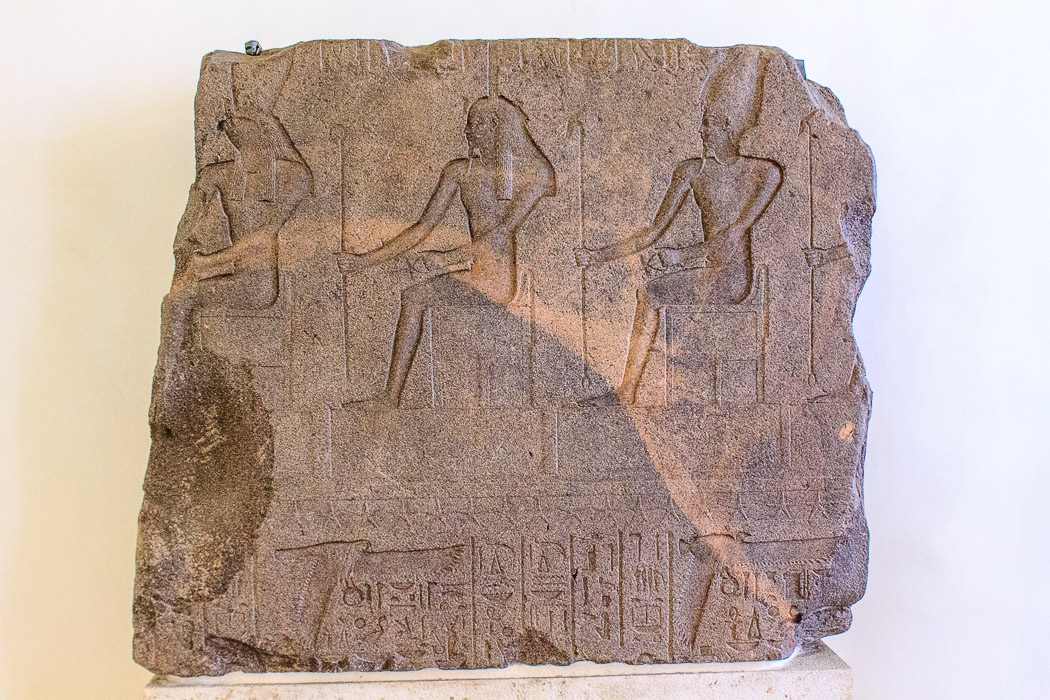
IMG_9657-20141010: Temple Relief from the Iseum in the Campus Martius depicts an Egyptian King making an offering to some deities, including Horus, Anedjiti, Osiris and Nekhbet, dating from the 4th century BC, in the National Museum of Rome, Palazzo Altemps
See all
National Museum of Rome - Palazzo Altemps photos.

IMG_9658-20141010: Male head, completely shaven, found near Santa Maria sopra Minerva, probably belonging to a priest, with many facial features having parallels in the Egyptian sculpture of the late 4th century BC, in the National Museum of Rome, Palazzo Altemps
See all
National Museum of Rome - Palazzo Altemps photos.

IMG_9659-20141010: Base of a Colossal Statue, from the Iseum and Serapeum of the Campus Martius, in the National Museum of Rome, Palazzo Altemps. All that survives of this statue are the feet on a parallelpiped base and part of the dorsal pillar with a hieroglyphic inscription. The careful execution of the signs and the colossal dimensions of the sculpture suggest that this was a royal figure made in Egypt, dating to the 3rd century BC.
See all
National Museum of Rome - Palazzo Altemps photos.

IMG_9661-20141010: Egyptian Statue of a Pharoah, carved by reusing parts of a column, represents a male figure wearing pharaonic garments, flanked by a smaller female figure carrying Isiac symbols, in the National Museum of Rome, Palazzo Altemps. The figures portrayed were long thought to be emperor Nero and a female member of his family. but more recent studies have suggested a depiction of Caesarion, the son of Julius Caesar and his mother Cleopatra, dating the work to the second half of the 1st century BC.
See all
National Museum of Rome - Palazzo Altemps photos.

IMG_9663-20141010: Bust of Serapis, portrays the god in accordance with his traditional iconography, with the typical headdress in the shape of a tall modius, the hairstyle with long locks over the forehead, and the thick, curly beard parted in the middle, from the 2nd half of the 2nd century AD, in the National Museum of Rome, Palazzo Altemps
See all
National Museum of Rome - Palazzo Altemps photos.

IMG_9664-20141010: Bust of Serapis, portrays the god in accordance with his traditional iconography, with the typical headdress in the shape of a tall modius, the hairstyle with long locks over the forehead, and the thick, curly beard parted in the middle, from the 2nd half of the 2nd century AD, in the National Museum of Rome, Palazzo Altemps
See all
National Museum of Rome - Palazzo Altemps photos.

See also: